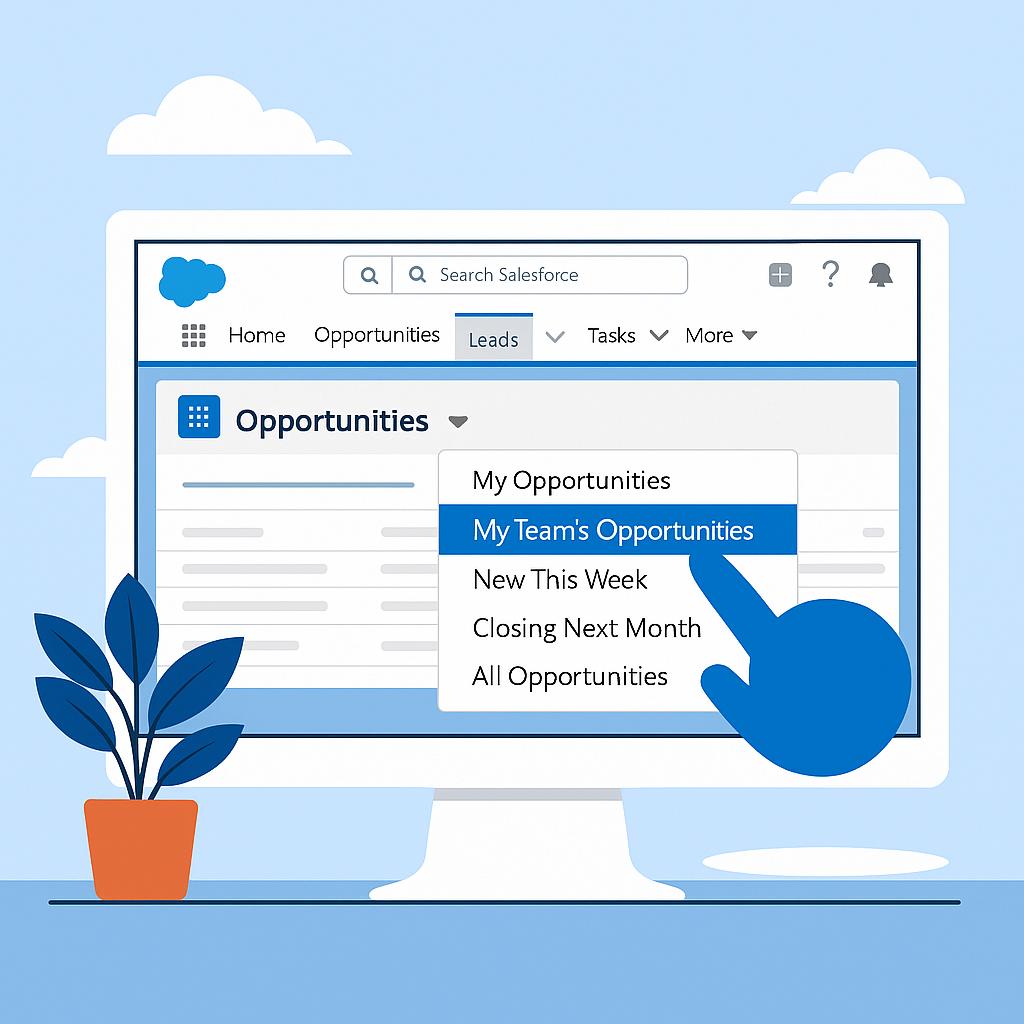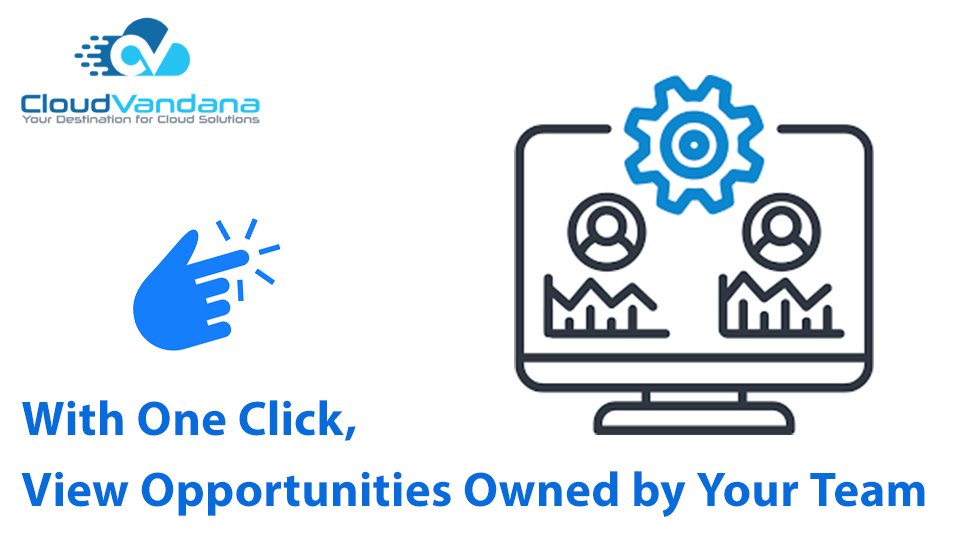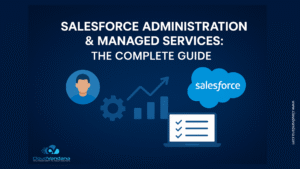View Opportunities Owned by Your Team with One Click in Lightning Experience
Time is the heartbeat of revenue operations. The faster a sales leader can see the pipeline owned by their team, the faster they can act—whether that means reallocating resources, coaching reps, or accelerating deals. In Salesforce Lightning Experience, the ability to view team-owned opportunities with a single click isn’t just a productivity feature—it’s a strategic advantage. This article dives into the configuration, logic, use cases, and best practices to enable this high-impact view.
The Problem with Default Opportunity Views
Manual Filters Waste Time
Default Salesforce views often require users to manually filter by owner or role, eating up time with every login.
Inconsistent Data Visibility
Without a consistent way to surface team-level opportunities, managers may miss key updates, overlook risks, or duplicate efforts.
Lack of Standardization Across Roles
Sales managers, regional leaders, and operations staff may all need to view team pipelines—but without a single standardized view, reporting and collaboration suffer.
The Power of “My Team’s Opportunities”
Built-In Role Hierarchy
Salesforce uses role hierarchy to determine visibility. When configured correctly, users higher in the hierarchy can view the records owned by users below them.

Instant Insights for Managers
With one click, a manager can surface every open opportunity assigned to their direct and indirect reports—sorted, filtered, and ready for review.
Unified Forecasting and Coaching
Whether reviewing deal health or prepping for 1:1s, team-owned opportunity views empower better forecasting and real-time rep coaching.
Enabling Team Opportunity Views in Salesforce
Step 1: Ensure Role Hierarchy is Configured
Go to Setup > Roles. Make sure managers are correctly positioned above their team members.
Step 2: Customize List Views
Navigate to the Opportunities tab > Click the gear icon > Select “New List View.”
Step 3: Use the “My Team’s Opportunities” Filter
Under filters, choose “My Team’s Opportunities” from the Owner field options.
Step 4: Add Useful Fields to the List View
Include critical fields such as Stage, Close Date, Amount, Opportunity Owner, and Forecast Category.
Step 5: Set the View as Default (Optional)
Allow users to make this the default view for faster access when opening the Opportunities tab.
Advanced Customization with Dynamic Dashboards
Create a Role-Based Dashboard
Design dashboards with filters that automatically adjust to the viewer’s role or hierarchy.
Add Opportunity Pipeline Components
Include charts showing total pipeline, deals by stage, and aging opportunities.
Enable Mobile Access for Managers on the Go
With the Salesforce mobile app, managers can tap into this visibility from anywhere.
Use Cases for One-Click Team Opportunity Views
1:1 Rep Coaching
Quickly spot stalled deals or high-value opportunities that need attention during regular rep meetings.
Regional Forecast Reviews
Regional directors can review all deals in their territory using the team filter—no manual exports needed.
Executive Pipeline Reviews
Sales VPs can drill down into any team in the org with consistent, high-level visibility.
Cross-Functional Collaboration
Marketing and RevOps can use team views to align campaign efforts with opportunity movement.
Common Pitfalls and How to Avoid Them
Pitfall 1: Misconfigured Role Hierarchy
If roles aren’t mapped properly, team views won’t reflect the right data. Always test role visibility.
Pitfall 2: Missing Owner Field Access
Ensure that all users have visibility to the Owner field and correct permissions for opportunity records.
Pitfall 3: Overcomplicated Filters
Keep list view filters simple. Too many conditions make the view harder to maintain and interpret.
Best Practices for Operational Excellence
Standardize Across Teams
Create a shared template or deploy a list view via Change Set for consistency across departments.
Train Managers to Use Views Effectively
Teach sales managers how to act on the data: flag risk, run QBRs, and update forecasts.
Combine with Inline Editing
Let managers update fields like Stage or Forecast Category directly from the list view.
Review List Views Quarterly
Business needs evolve. Revisit and refine list view fields and filters at least once per quarter.
Enhancing Visibility with Reports and Alerts
Build a “My Team Pipeline” Report
Create a custom report using the “My Team’s Opportunities” scope for deeper insights.
Schedule Weekly Pipeline Emails
Send automated pipeline summaries to managers every Monday morning.
Set Up Notifications for At-Risk Deals
Use process builder or flow to trigger alerts when high-value deals are stuck in stage.
Bringing It All Together with App Pages
Create a Manager-Focused Lightning App Page
Add tabs for team list view, reports, dashboards, and notes in one workspace.
Customize Navigation Items
Make “Team Opportunities” a top item in the navigation bar to save time.
Disable Personalization (If Needed)
Admins can lock down the layout to ensure consistency across users.
Why CloudVandana Recommends This Setup
As Salesforce experts, we’ve seen that giving managers quick, reliable access to team data accelerates decision-making and improves pipeline health. It supports agile operations, eliminates silos, and empowers front-line leaders to act faster.
Conclusion: Visibility Creates Velocity
When you enable sales leaders to view their team’s opportunities with a single click, you remove friction from the sales process. You unlock data-driven leadership, faster decisions, and higher accountability. In Salesforce Lightning Experience, it’s not just possible—it’s essential.
Need help setting this up in your org? Contact CloudVandana to optimize your Salesforce experience today.
Frequently Asked Questions
1. What is the “My Team’s Opportunities” list view in Salesforce?
The “My Team’s Opportunities” list view allows users to quickly see all opportunities owned by users beneath them in the role hierarchy. It provides a consolidated view for managers and team leads without needing to switch between individual user records.
2. How do I enable role hierarchy to use team-based list views?
Go to Setup → Sharing Settings, and ensure that Grant Access Using Hierarchies is enabled for the Opportunity object. Then, configure your organization’s Role Hierarchy under Roles so that managers can access records owned by their direct reports.
3. Can I customize the fields shown in the “My Team’s Opportunities” view?
Yes. You can customize columns in any list view, including “My Team’s Opportunities”, using the gear icon (⚙️) → Select Fields to Display. You can also apply filters, sorting, and even enable Kanban or Chart views for more visual management.
















